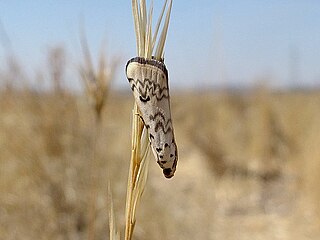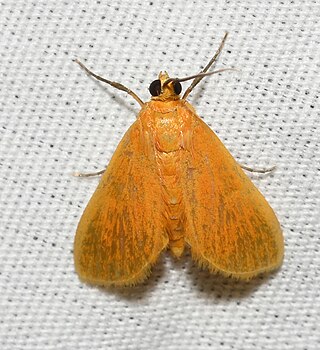
Anageshna is a monotypic moth genus of the family Crambidae described by Eugene G. Munroe in 1956. Its only species, Anageshna primordialis, the yellow-spotted webworm, was described by Harrison Gray Dyar Jr. in 1907. It is found in the US states of Alabama, Arkansas, Arizona, Florida, Georgia, Iowa, Illinois, Kansas, Louisiana, Massachusetts, Maryland, Maine, Minnesota, Missouri, Mississippi, North Carolina, New Hampshire, New Jersey, New York, Ohio, Oklahoma, Pennsylvania, South Carolina, Texas, Virginia and West Virginia.
Lissophanes is a genus of moths of the family Crambidae. It contains only one species, Lissophanes ceramica, which is found in Peru.
Delogenes is a monotypic snout moth genus. Its only species, Delogenes limodoxa, is found in New Zealand. Both the genus and species were described by Edward Meyrick in 1918.

Euzophera lunulella is a species of snout moth in the genus Euzophera. It was described by O.-G. Costa in 1836. It is found in Spain, France, Italy, Albania, North Macedonia, Greece and on Crete.
Lamida moncusalis, the cashew shoot and blossom webber, is a species of snout moth in the genus Lamida. It was described by Francis Walker in 1859. It is found in India.
Orthaga seminivea is a species of snout moth in the genus Orthaga. It is found in Australia.
Trischistognatha limatalis is a moth in the family Crambidae. It is found in Costa Rica.
Trischistognatha ochritacta is a moth in the family Crambidae. It is found in Mexico.
Neurophyseta avertinalis is a moth in the family Crambidae described by William Schaus in 1924. It is found in Cuba.
Neurophyseta dabiusalis is a moth in the family Crambidae. It is found in Mexico.
Undulambia arnoulalis is a moth in the family Crambidae described by William Schaus in 1925. It is found in Mexico.
Hahncappsia sacculalis is a moth in the family Crambidae. It is found in Venezuela.
Hahncappsia straminea is a moth in the family Crambidae. It is found in Mexico.
Hahncappsia volcanensis is a moth in the family Crambidae described by Hahn William Capps in 1967. It is found in Guatemala, Costa Rica and Venezuela.
Hahncappsia yucatanalis is a moth in the family Crambidae. It is found in Mexico (Yucatán).

Helvibotys pucilla is a moth in the family Crambidae first described by Herbert Druce in 1895. It is found in Guatemala, Costa Rica, the Mexican state of Veracruz and the United States, where it has been recorded from Kentucky, Oklahoma and Texas
Pyrausta ploimalis is a moth in the family Crambidae. It is found in Panama.
Ramila ruficostalis is a moth in the family Crambidae. It was described by George Hampson in 1893. It is found in Sri Lanka.
Tulaya margelana is a moth in the family Crambidae. It was described by George Thomas Bethune-Baker in 1893. It is found in Iran.
Tulaya staudingeri is a moth in the family Crambidae. It was described by George Thomas Bethune-Baker in 1893. It is found in Iran.


